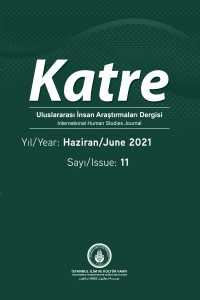Abstract
Nursi describes human I as a key to open the hidden treasures of the cosmos; but ‘I’ is also a double-edgedsword, an Alif; one face pointing towards materialism and the other towards God. When man turns towards materialism and becomes his own master, the real essence of I is lost. When human I gets corrupted, Nursi believes that the corruption of human I reduces the value of Allah’s bounties. But, on the other hand, ‘I’ is the source of all knowledge; therefore, it is necessary to know the nature and existence of the ‘I’. There cannot be any other way to know the true nature of the I, except through the ‘I’ itself. The study aims to comprehend the true nature of the human ‘I’ based on Nursi’s perspective. It also makes a differentiation between Nafs, Ruh and the human I, as the terms are loosely used interchangeably. For Nursi, the Divine Names are a source of Ma’rifatullah, but these Names themselves manifest through human I. This statement brings human I and Asma ul-Husna in close conformity with Ma’rifatullah. The paper tries to explore this relationship between Asma ul-Husna, Ma’rifatullah and the human I. This study, which has the features of a qualitative research, used the text analysis method.
Thanks
My special thanks is due for 5D Thinking Team, especially, Prof. Colin Turner, Prof. Nacati, Prof. Alparslan Acikgenc and Prof. Hakan
References
- Acikgenc Alparslan (2014). Islamic Scientific Tradition in History, Malaysia: IKIM. Aydin Necati (2019). Said Nursi and Science in Islam; Character Building Through Nursi Mana-I-Harfi, London: Routledge Taylor and Francis Group. Cobb Kelton (2003). Revelation, the Disciplines of Reason, and Truth in the Works of Said Nursi and Paul Tillich, Islam At The Crossroads, New York: State University of New York Press. Gok Hakan (2016). Selected Readings from Bediuzzaman Said Nursi’s Risale-I Nur, Clifton: Tugra Books.
- Kuhan Thomas S. (2012). The Structure of Scientific Revolutions, London: The University of Chicago Press. Sayyid Mawdudi (2011). Towards Understanding the Quran, New Delhi: MMI Publishers.
Abstract
Nursi, insan Ene’sinin, kozmosun gizli hazinelerini açmak için bir anahtar olduğunu bildirir; ama "Ene" aynı zamanda iki ucu keskin bir bıçaktır; bir yüzü materyalizme, diğeri Allah'a dönük bir Eliftir. İnsan materyalizme dönüp kendi efendisi olduğunda, Enenin gerçek özü kaybolur. Nursi, insanın Ene’si bozulduğunda, Allah'ın nimetlerinin değerini düşürdüğüne inanır. Fakat diğer taraftan Nursi'ye göre Ene tüm bilginin kaynağıdır; bu sebeple, Ene’nin mahiyetini ve varlığını bilmek gerekir. Nursi'nin belirttiği gibi, Ene'nin kendisi dışında, Ene'nin gerçek mahiyetini bilmenin başka yolu yoktur. Bu çalışmainsan Ene’sinin gerçek tabiatını Nursi’nin perspektifinden anlamayı amaçlamaktadır. Bu çalışma ayrıca, birbirinin yerine gevşek bir şekilde kullanılabilen Nefis, Ruh ve insan Ene’si arasında da bir ayrım yapar. Nursi'ye göre, İlahi İsimler mâ’rifetullahın bir kaynağıdır, ancak bu İsimler insan Ene’si aracılığıyla tezahür eder. Bu ifade, insan Ene’sini ve Esma ül- Hüsna'yı ma’rifetullah ile yakın uyum içine getirir. Makale Esma ül-Hüsna, Ma’rifetullah ve insan Ene’si arasındaki bu ilişkiyi ortaya koymaya çalışmaktadır. Nitel araştırma özelliğini taşıyan bu çalışma metin analizi yöntemini kullanmıştır.
Keywords
References
- Acikgenc Alparslan (2014). Islamic Scientific Tradition in History, Malaysia: IKIM. Aydin Necati (2019). Said Nursi and Science in Islam; Character Building Through Nursi Mana-I-Harfi, London: Routledge Taylor and Francis Group. Cobb Kelton (2003). Revelation, the Disciplines of Reason, and Truth in the Works of Said Nursi and Paul Tillich, Islam At The Crossroads, New York: State University of New York Press. Gok Hakan (2016). Selected Readings from Bediuzzaman Said Nursi’s Risale-I Nur, Clifton: Tugra Books.
- Kuhan Thomas S. (2012). The Structure of Scientific Revolutions, London: The University of Chicago Press. Sayyid Mawdudi (2011). Towards Understanding the Quran, New Delhi: MMI Publishers.
Details
| Primary Language | English |
|---|---|
| Subjects | Religious Studies |
| Journal Section | Refereed Articles |
| Authors | |
| Publication Date | June 30, 2021 |
| Submission Date | January 13, 2021 |
| Acceptance Date | June 11, 2021 |
| Published in Issue | Year 2021 Issue: 11 |

Katre International Human Studies Journal is open access journal under the CC BY-NC license (Creative Commons Attribution 4.0 International License)
Based on a work at https://dergipark.org.tr/en/pub/katre
E-mail: katre@iikv.org


